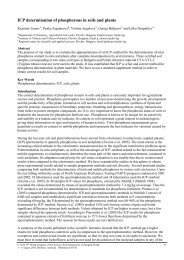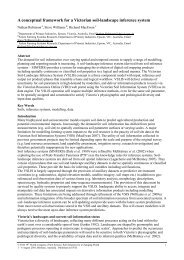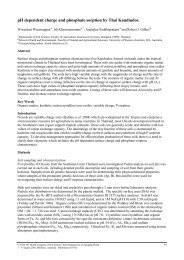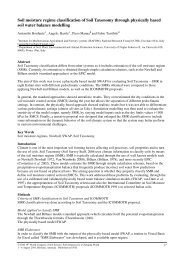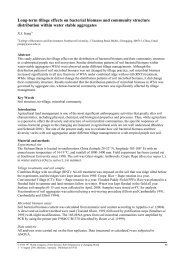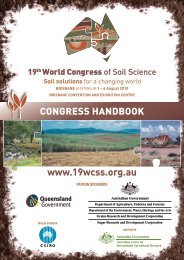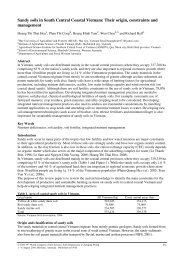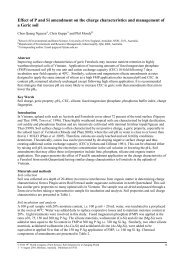Soil art - International Union of Soil Sciences
Soil art - International Union of Soil Sciences
Soil art - International Union of Soil Sciences
You also want an ePaper? Increase the reach of your titles
YUMPU automatically turns print PDFs into web optimized ePapers that Google loves.
<strong>Soil</strong> <strong>art</strong>: bridging the communication gap<br />
Alexandra R. Toland A and Gerd Wessolek B<br />
A Institute for Ecology, Dept. <strong>of</strong> <strong>Soil</strong> Protection, Technical University <strong>of</strong> Berlin, Germany, Email alex.toland@fertileground.de<br />
B Institute for Ecology, Dept. <strong>of</strong> <strong>Soil</strong> Protection, Technical University <strong>of</strong> Berlin, Germany, Email gerd.wessolek@tu-berlin.de<br />
Abstract<br />
The rise <strong>of</strong> industrial agriculture paired with a global demographic shift <strong>of</strong> populations from rural to urban<br />
settings has diminished everyday interaction with soil for most members <strong>of</strong> society. This has led to a<br />
deterioration <strong>of</strong> the aesthetic image and cultural value <strong>of</strong> soil. Among other efforts to increase soil<br />
awareness, concerned <strong>art</strong>ists have been reclaiming the image <strong>of</strong> soil as a culturally, aesthetically and<br />
ecologically invaluable common good. From the early environmental <strong>art</strong> <strong>of</strong> the 60s and 70s to more recent<br />
<strong>art</strong>works on urban and industrial brownfields, soil functions such as growth medium and habitat, archive and<br />
contamination filter have become subject matter for <strong>art</strong>istic expression and public discourse. In the following<br />
paper we present soil in the context <strong>of</strong> the environmental <strong>art</strong>s movement as well as <strong>art</strong> in the context soil<br />
science. How can <strong>art</strong> contribute to soil conservation – both with the aim <strong>of</strong> generating greater public<br />
understanding and promoting cultural values, but also by developing creative methods to directly confront<br />
problems such as contamination, erosion, or humus loss? Based on a brief review <strong>of</strong> well-known <strong>art</strong>works, a<br />
survey <strong>of</strong> soil scientists, interviews with <strong>art</strong>ists, and our own creative field experiments, we address the use<br />
<strong>of</strong> <strong>art</strong> in bridging communication gaps between soil conservation and the general public.<br />
Key Words<br />
<strong>Soil</strong> Art, soil communication, reclamation aesthetics, creative collaboration, interdisciplinary research.<br />
Introduction<br />
Cultural utilization <strong>of</strong> soil as expressive media, e.g. as pigment (see Ugolini 2010), sculptural or structural<br />
material, predates its appropriation for agriculture. While aesthetic uses <strong>of</strong> soil may be identified throughout<br />
human history, the rise <strong>of</strong> industrial agriculture paired with a global demographic shift <strong>of</strong> populations from<br />
rural to urban settings has diminished everyday interaction with soil for most members <strong>of</strong> modern society. In<br />
the absence <strong>of</strong> aboriginal or agricultural relationships with the e<strong>art</strong>h, the aesthetic value and cultural context<br />
<strong>of</strong> soil deteriorates and the psychological gap between human populations and the e<strong>art</strong>h widens. The image<br />
and identity <strong>of</strong> soil is reduced to dirt.<br />
Despite this lack <strong>of</strong> appreciation, current soil conservation relies almost exclusively on soil scientific<br />
principles. In so doing, it neglects cultural values and strategies, which could improve human perception and<br />
also ideally human treatment <strong>of</strong> soil. In recent years several publications have addressed this issue by<br />
encouraging stronger integration <strong>of</strong> soil science in education from kinderg<strong>art</strong>en through university<br />
(Herrmann 2006; Smiles et al. 2000), better public reference tools (Van Baren et al. 1998), consideration <strong>of</strong><br />
social and cultural research (Greenland 1991; Minami 2009; Winiw<strong>art</strong>er 2006) and the introduction <strong>of</strong> <strong>art</strong> as<br />
a tool <strong>of</strong> environmental communication and consciousness-raising (Feller, Lardy and Ugolini 2010; Van<br />
Breemen 2010; Toland and Wessolek 2010). This last point is the focus <strong>of</strong> our present inquiry.<br />
While scientific research provides lawmakers and public stakeholders with numerical analyses and expert<br />
prognoses, <strong>art</strong> plays a vital role in communicating environmental issues to the greater public. Because <strong>art</strong> is a<br />
free, experimental format where ideas can be independently and critically tested before ending up in<br />
mainstream media, <strong>art</strong> can be seen as an indicator <strong>of</strong> shifts in cultural values or norms. If we consider <strong>art</strong> not<br />
only as cultural indicator but also as instrument, which can be planned and integrated into public space and<br />
urban culture, we can regard <strong>art</strong> as a resource or service <strong>of</strong> environmental communication and conservation.<br />
The significance <strong>of</strong> <strong>art</strong> in scientific fields such as information and communications technology, robotics, and<br />
materials science is reflected at <strong>art</strong> festivals such as the Ars Electronica in Linz, Austria and the<br />
Transmediale in Berlin, Germany. However, an information gap seems to persist between environmental <strong>art</strong><br />
and environmental science. Wilson (2002a) has suggested that <strong>art</strong> and science operate as intersecting cultural<br />
duties. “Bridging the communication gap” is therefore seen as a cultural duty <strong>of</strong> both scientists and <strong>art</strong>ists<br />
working with soil, in order to improve public awareness and achieve a broader approach to soil conservation.<br />
Bouma and H<strong>art</strong>emink (2002) have emphasized the need for interdisciplinary research programs to support<br />
© 2010 19 th World Congress <strong>of</strong> <strong>Soil</strong> Science, <strong>Soil</strong> Solutions for a Changing World 8<br />
1 – 6 August 2010, Brisbane, Australia. Published on DVD.
communication between soil scientists, planers, politicians, and other stakeholders. Yaalon (1996) has<br />
similarly suggested the need for soil technology transfer between societies <strong>of</strong> industrial and developing<br />
nations. The cultivation <strong>of</strong> pr<strong>of</strong>essional research p<strong>art</strong>nerships is also necessary for accurate knowledge<br />
transfer between scientific and <strong>art</strong>istic disciplines. Organizations such as the Leonardo <strong>International</strong> Society<br />
for the Arts, <strong>Sciences</strong> and Technology (ISAST), the Art and Science Collaborations Inc. (ASCI), and the<br />
Arts and Ecology Program <strong>of</strong> the Royal Society for the Arts attempt to bridge this divide. <strong>International</strong><br />
projects such as Cape Farewell and the 350.org campaign have brought together <strong>art</strong>ists, scientists and<br />
educators to raise awareness about climate change. Despite many individual examples, no equivalent<br />
interdisciplinary program yet exists to address soil conservation issues on a larger cultural scale.<br />
By communicating examples <strong>of</strong> soil <strong>art</strong> to a mostly scientific audience, this presentation functions as one<br />
step in such a knowledge transfer process. Conversely, we are interested in the creative aspects <strong>of</strong> scientific<br />
research, and how these might inform and enrich <strong>art</strong>istic practice. Our larger goal is to encourage creative<br />
science-<strong>art</strong> collaboration. Based on a brief review <strong>of</strong> <strong>art</strong>works, a survey <strong>of</strong> soil scientists, interviews with<br />
<strong>art</strong>ists, and our own creative field experiments, we explore opportunities <strong>of</strong> collaboration, both with the aim<br />
<strong>of</strong> generating greater public understanding, but also by combining methodological expertise to confront<br />
problems such as contamination, erosion and stronger legal conservation.<br />
Art-historical context: soil as subject matter<br />
Depictions <strong>of</strong> soil and geologic forms may be identified in almost all major <strong>art</strong>istic genres. However, <strong>art</strong>work<br />
explicitly dealing with soil and soil conservation issues is characteristic to the environmental <strong>art</strong>s movement<br />
spanning over the last 50 years. From the Land Art <strong>of</strong> the 60s and 70s to more recent environmental <strong>art</strong><br />
projects, it is important to distinguish between <strong>art</strong>works that utilize a symbolic reference to “e<strong>art</strong>h,” and<br />
those that contextualize “soil” as a geophysical and biochemical body. We introduce soil <strong>art</strong> as: <strong>art</strong><br />
consciously in or with soil or about soil conservation issues, expressed via a wide range <strong>of</strong> <strong>art</strong>istic<br />
disciplines, resulting in a multisensory aesthetic experience (Toland and Wessolek 2010a).<br />
Two main approaches to soil <strong>art</strong> should be <strong>art</strong>iculated: <strong>art</strong>work that is primarily concerned with the formal<br />
aesthetic properties <strong>of</strong> soils, and <strong>art</strong>work that is ecologically restorative and thus “functional.” Barbara<br />
Matilsky (1992 p. 56) makes a similar distinction between <strong>art</strong>ists who have “proposed or created ecological<br />
<strong>art</strong>works that provide solutions to the problems facing natural and urban ecosystems,” and <strong>art</strong>ists who hone<br />
their skills to attract attention or create awareness <strong>of</strong> environmental issues by “framing the problems through<br />
a variety <strong>of</strong> media…” The early Land Artists, for example, were mainly occupied with aesthetic form,<br />
embedding visual symbols from the minimalist and post-modern movements into remote natural settings.<br />
Artists such as Michael Heizer, Walter de Maria, Robert Morris, and Robert Smithson provoked new ways <strong>of</strong><br />
perceiving the environment by bulldozing monumental shapes into the landscape and exhibiting piles <strong>of</strong> soil<br />
and rocks as sculptural works. Around the same time period a more reactionary group <strong>of</strong> environmental<br />
<strong>art</strong>ists, including e.g. Alan Sonfist, Newton and Helen Mayer Harrison, Agnes Denes, and Joseph Beuys,<br />
concentrated their <strong>art</strong>istic efforts on repairing and restoring urban ecosystems.<br />
Art facilitates dialog, afterthought and the transference <strong>of</strong> new ideas. It has the ability to reach unexpected<br />
audiences and provide new perspectives on the environment and our relation to it. While it might be difficult<br />
to literally transform equations for preferential flow into meaningful <strong>art</strong>work, we may link different <strong>art</strong>istic<br />
motifs to specific soil functions that most everyone can relate to and understand. In this sense, we may<br />
associate human fertility with soil fertility in the works <strong>of</strong> Charles Simonds, Ana Mendieta or Shai Zakai, or<br />
learn to appreciate the archival function <strong>of</strong> soils in the survey and documentation projects <strong>of</strong> Betty Beier,<br />
Daro Montag, and Marianne Greve.<br />
Despite “a pr<strong>of</strong>usion <strong>of</strong> terms” (Bower 2009), including Land Art, e<strong>art</strong>h <strong>art</strong>, environmental <strong>art</strong>, and now soil<br />
<strong>art</strong>, the term eco-<strong>art</strong> historically refers to <strong>art</strong> with and for nature as opposed to <strong>art</strong> simply about or in nature<br />
(Aagerstoun 2007). In areas with weak mitigation policies, eco-<strong>art</strong> has come to fill a planning void in<br />
degenerate landscapes. Land remediation and mitigation is disguised as sculpture and performance <strong>art</strong>. Some<br />
interdisciplinary projects are unique in that they are either initiated by or include <strong>art</strong>ists in solving local and<br />
regional environmental problems. For example, the Acid Mine Drainage and Art project (1994 – 2005) in<br />
Vintondale, Pennsylvania is a tribute to the cultural and environmental heritage <strong>of</strong> the mining region. Artist<br />
Stacy Levy designed a passive water treatment system, or "Litmus Garden," to help communicate soil<br />
processes <strong>of</strong> buffering and filtration. Initiated by <strong>art</strong> pr<strong>of</strong>essors Tim Collins, Reiko Goto and Bob Bingham<br />
© 2010 19 th World Congress <strong>of</strong> <strong>Soil</strong> Science, <strong>Soil</strong> Solutions for a Changing World 9<br />
1 – 6 August 2010, Brisbane, Australia. Published on DVD.
<strong>of</strong> the Carnegie Mellon Studio for Creative Inquiry, the Nine Mile Run greenway restoration project in<br />
Pittsburg, Pennsylvania also addresses complex soil remediation processes. On a smaller scale, <strong>art</strong>ist Georg<br />
Dietzler has confronted soil contamination issues by using mycoremediation (i.e., remediation facilitated by<br />
fungi) in his long-term installation projects. In works such as Self-Decomposing Laboratory (1999) and<br />
Moveable Oyster Mushroom Patch (1996-1997), Dietzler makes use <strong>of</strong> the edible oyster mushroom<br />
(Pleurotus ostreatus) to break down organic pollutants such as PCBs (polychlorinated biphenyls). In a<br />
similar bioremediation project, the “Revival Field” (1990 – 1993), <strong>art</strong>ist Mel Chin planted a field <strong>of</strong> heavy<br />
metal absorbing “hypo-accumulators” at the Pig’s Eye Landfill in Minnesota. In his most recent project,<br />
“Paydirt,” Chin launched a public awareness campaign about the high lead content in New Orleans’ soils, a<br />
problem that has increased long after the floodwaters <strong>of</strong> Hurricane Katrina receded.<br />
<strong>Soil</strong> science context: <strong>art</strong> as vehicle<br />
The examples given above are icons <strong>of</strong> eco-<strong>art</strong>. They challenge traditional <strong>art</strong> forms with the development <strong>of</strong><br />
a new visual vocabulary, reclamation aesthetics (Spaid 2002, p. 109; Toland and Wessolek 2010b). As soil<br />
resources become scarcer and scientists look for new approaches to soil protection, eco-<strong>art</strong> and its derivative<br />
soil-<strong>art</strong> might be considered new cultural allies. While relatively more people are involved in the <strong>art</strong>s than<br />
have access to the complicated topics <strong>of</strong> soil science, a combination <strong>of</strong> soil science and <strong>art</strong> could <strong>of</strong>fer soil a<br />
new public image (Wessolek 2002). Art may be seen as a “vehicle” to spark interest and promote a wider<br />
understanding <strong>of</strong> the hidden resource beneath our feet. Artistic involvement, however, need not always result<br />
in a conventional object or exhibition, but can be seen as a creative phase in conservation, education and<br />
public awareness programs. Because cities boast a concentration <strong>of</strong> cultural and <strong>art</strong>istic activity as well as<br />
acclaimed research and academic institutions, urban soils can be considered a natural st<strong>art</strong>ing point for<br />
interdisciplinary collaboration. This is reflected in the selection <strong>of</strong> <strong>art</strong>works above, many <strong>of</strong> which were<br />
created in urban and industrial areas. While the field <strong>of</strong> soil science has traditionally focused on optimizing<br />
soil as a resource for the production <strong>of</strong> food and fuel, city soils have historically been evaluated on different<br />
terms – that is, as medium for buildings and infrastructure. An increase in urban ecological research has led<br />
to new forms <strong>of</strong> perception and environmental protection objectives in cities. For example, urban soils <strong>of</strong>fer<br />
a unique perspective into history. An archive <strong>of</strong> war, peace, cultural, and environmental change is preserved<br />
beneath our backyards and sidewalks. Urban agriculture and on-site rainwater harvesting have also become<br />
important topics for subsistence farmers in developing nations as well as slow-food activists in industrialized<br />
nations. The diversity, dynamics and vulnerability <strong>of</strong> urban soils demand a need for awareness, acceptance<br />
and education and thus provide creative stimulus for <strong>art</strong>istic involvement.<br />
The Dep<strong>art</strong>ment <strong>of</strong> <strong>Soil</strong> Protection at the TU-Berlin has been investigating several approaches to <strong>art</strong>pedology<br />
in recent years. Our own attempts <strong>of</strong> cultivating <strong>art</strong> as a vehicle <strong>of</strong> communication include: a soil<br />
and <strong>art</strong> group that was founded in 2000, the organization <strong>of</strong> several soil-<strong>art</strong> exhibitions, and a permanent<br />
collection <strong>of</strong> soil-<strong>art</strong> on display in the Gorbatschow Building <strong>of</strong> the TU Campus. In 2007 and 2008, we led a<br />
series <strong>of</strong> creative field exercises in an overgrown urban lot near the TU campus. Landscape planning and<br />
environmental engineering students and staff were encouraged to paint their impressions <strong>of</strong> the site with<br />
materials found on or buried in the soil. Since 2002, several thesis papers and three semester-long student<br />
projects have also dealt with the topic <strong>of</strong> soil and <strong>art</strong>. For example, Andreas Vetter created plans for an urban<br />
soil park and Hardy Buhl installed a giant “soil cake” sculpture to demonstrate the remediation <strong>of</strong> a former<br />
wastewater-leaching field. In another example Fritz Kleinschroth and the student project group <strong>Soil</strong> Art on<br />
Urban Brownfields created an oversized “ecological footprint” made <strong>of</strong> onion peels and other kitchen scraps<br />
from a city homeless shelter (Figure 1). The footprint was “stamped” on the “Gleisdreieck,” a former goods<br />
depot in Berlin. A time-lapse video <strong>of</strong> the disappearing footprint was made to illustrate processes <strong>of</strong><br />
humification and mineralization. More student films can be found on youtube under: media, soil, tu-berlin.<br />
Figure 1. “Ecological Footprint” by Fritz Kleinschroth and the student project group “<strong>Soil</strong> Art on Urban<br />
Brownfields.” Time Lapse Documentation <strong>of</strong> 20 m 2 <strong>of</strong> food scraps and carrot peels, Gleisdreieck Berlin, 2007.<br />
© 2010 19 th World Congress <strong>of</strong> <strong>Soil</strong> Science, <strong>Soil</strong> Solutions for a Changing World 10<br />
1 – 6 August 2010, Brisbane, Australia. Published on DVD.
Bridging the gap: creative collaboration, opportunities, and challenges<br />
To address the idea <strong>of</strong> creative collaboration between soil scientists and soil <strong>art</strong>ists, we have been gathering<br />
opinions from both fields. In 2007, we drafted a questionnaire on soil science, aesthetics and <strong>art</strong>, which was<br />
distributed at the German <strong>Soil</strong> Science Society’s annual conference at a session on soil science, society and<br />
education and subsequently carried out at conferences in Australia, New Zealand and China. We asked<br />
members to share their opinions about the aesthetic properties <strong>of</strong> soil and their potential willingness to<br />
collaborate with <strong>art</strong>ists. 85% answered that they would be personally willing to cooperate with an <strong>art</strong>ist,<br />
while about 64% regarded the interdisciplinary direction <strong>of</strong> “soil <strong>art</strong>” as important. The results <strong>of</strong> this inquiry<br />
are included in our contribution to the book <strong>Soil</strong> and Culture (Landa and Feller 2010).<br />
In January 2010 we carried out fifteen in-depth interviews with ecological <strong>art</strong>ists who have worked with soil<br />
or soil conservation issues. Artistic formats included sculpture, ceramics, installation, illustration, painting,<br />
performance, video, graphic design, interactive or p<strong>art</strong>icipatory interventions, educational events, and<br />
landscape design. Environmental themes included moor degradation, acid mine drainage, rainwater<br />
harvesting, urban agriculture, pedodiversity, and coastal reforestation. Given this wide range <strong>of</strong> soil issues<br />
and <strong>art</strong>istic approaches, the topics <strong>of</strong> didactic aesthetics and restoration aesthetics came up in almost all<br />
interviews. Although most <strong>of</strong> the <strong>art</strong>ists answered that they thought about content first and then form, about<br />
half <strong>of</strong> the <strong>art</strong>ists felt that <strong>art</strong> should inspire through innovative form, rather rely too heavily on informative<br />
texts or educational props. One <strong>art</strong>ist described her <strong>art</strong> as a form <strong>of</strong> subservience – a service to community<br />
and environment. Other <strong>art</strong>ists spoke <strong>of</strong> their work as an ethical or spiritual duty to nature. All but one <strong>art</strong>ist<br />
described instances <strong>of</strong> collaboration, which differed when working with other <strong>art</strong>ists, scientists, city planners<br />
and educators. All <strong>art</strong>ists described an interdisciplinary nature to their work and expressed interest in<br />
collaborating with scientists, although most had already worked together with scientists and engineers.<br />
We are continuing our inquiry into collaborative science-<strong>art</strong> research with an extended questionnaire to be<br />
distributed in 2010 and 2011 at academic conferences and online venues. Further interviews as well as a<br />
more comprehensive analysis <strong>of</strong> completed interviews are also planned. A list <strong>of</strong> other projects,<br />
organizations, and <strong>art</strong>ists, can be found on our soil <strong>art</strong>s website, as well online platforms such as the green<br />
museum, eco <strong>art</strong> space and <strong>art</strong>s and ecology website (see references below). In a contemporary integration <strong>of</strong><br />
<strong>art</strong> and science, we must constantly examine the parallels that arise between an ever converging critical <strong>art</strong>world<br />
and a culturally literate scientific community. This is necessary for any attempt to combine soil<br />
science and <strong>art</strong>. Both fields must inform themselves <strong>of</strong> the others’ developments if they are to take p<strong>art</strong> in<br />
constructive dialogue. Conscious cross-referencing and frequent communication is needed. This is not an<br />
observation, but a call to action. Pr<strong>of</strong>essional <strong>art</strong>ists and cultural theorists should be invited more <strong>of</strong>ten to<br />
academic conferences, into laboratories, and to contribute to engineering and agricultural research, while soil<br />
scientists might <strong>of</strong>fer their expertise at environmental <strong>art</strong> symposiums, exhibitions and seminars.<br />
References<br />
Aagerstoun MJ (2007) ‘Eco<strong>art</strong> and Eco<strong>art</strong>ists’. http://www.sfeap.org/eco<strong>art</strong>eco<strong>art</strong>ists.html<br />
Bouma and H<strong>art</strong>emink (2002) <strong>Soil</strong> Science and Society in the Dutch Context. NJAS Wageningen Journal <strong>of</strong> Life<br />
<strong>Sciences</strong>. 50-2, 133-140.<br />
Bower S (2009) ‘A Pr<strong>of</strong>usion <strong>of</strong> Terms’. http://www.greenmuseum.org/generic_content.php?ct_id=306<br />
Feller, Lardy, Ugolini (2010) The Representation <strong>of</strong> <strong>Soil</strong> in the Western Art: From Genesis to Pedogenesis. In<br />
‘<strong>Soil</strong> and Culture’ (Eds Feller, Landa) pp. 3-21. (Springer Science + Business Media B.V.: Dordrecht,<br />
Heidelberg: London and New York).<br />
Greenland DJ (1991) The Contributions <strong>of</strong> <strong>Soil</strong> Science to Society – Past, Present, and Future. <strong>Soil</strong> Science 151,<br />
19–23.<br />
Herrmann L (2006) <strong>Soil</strong> education: A public need Developments in Germany since the mid 1990s. Journal <strong>of</strong><br />
Plant Nutrition and <strong>Soil</strong> Science 169, 464–471.<br />
Landa ER, Feller C (2010) ‘<strong>Soil</strong> and Culture’. (Springer Science + Business Media B.V.: Dordrecht, Heidelberg:<br />
London and New York).<br />
Matilsky B (1992) Ecological Art: A Response to Environmental Issues. In ‘Fragile Ecologies: Contemporary<br />
Artists’ Interpretations and Solutions’. (Ed Matilsky) pp.56-60. (Rizzoli <strong>International</strong> Publications, Inc.: New<br />
York).<br />
Minami K (2009) <strong>Soil</strong> and Humanity: Culture, Civilization, Livelihood and Health. <strong>Soil</strong> Science and Plant<br />
Nutrition 55, 603-615.<br />
Smiles DE, White I, Smith CJ (2000) <strong>Soil</strong> Science Education and Society. <strong>Soil</strong> Science 165, 87–97.<br />
Spaid S (2002) Reclamation and Restoration Aesthetics. In ‘Ecovention – Current Art to Transform Ecologies’<br />
© 2010 19 th World Congress <strong>of</strong> <strong>Soil</strong> Science, <strong>Soil</strong> Solutions for a Changing World 11<br />
1 – 6 August 2010, Brisbane, Australia. Published on DVD.
(Ed Spaid) pp. 109-130. (The Contemporary Arts Center, Eco<strong>art</strong>space: Cincinnati, OH)<br />
Toland A, Wessolek G (2010a) Merging Horizons – <strong>Soil</strong> Science and <strong>Soil</strong> Art. In ‘<strong>Soil</strong> and Culture’. (Eds Feller<br />
and Landa) pp. 45-66. (Springer Science + Business Media B.V.: Dordrecht, Heidelberg, London and New<br />
York).<br />
Toland A, Wessolek G (2010a) Core Samples <strong>of</strong> the Sublime – On the Aesthetics <strong>of</strong> Dirt. In ‘<strong>Soil</strong> and Culture’.<br />
(Eds Feller, Landa) pp. 239-257. (Springer Science + Business Media B.V.: Dordrecht, Heidelberg, London<br />
and New York).<br />
Ugolini F (2010) <strong>Soil</strong> Colors, Pigments and Clays in Paintings. In ‘<strong>Soil</strong> and Culture’. (Eds Feller, Landa) pp. 67-<br />
82. (Springer Science + Business Media B.V.: Dordrecht, Heidelberg, London and New York).<br />
Wessolek G (2002). ‘Art and <strong>Soil</strong>: Newsletter No 10’ (The Committee on the History, Philosophy, and Sociology<br />
<strong>of</strong> <strong>Soil</strong> Science <strong>International</strong> <strong>Union</strong> <strong>of</strong> <strong>Soil</strong> Science and Council on the History, Philosophy, and Sociology <strong>of</strong><br />
the <strong>Soil</strong> Science <strong>Soil</strong> Science Society <strong>of</strong> America, 10).<br />
Wilson S (2002a). Art and Science as Cultural Acts: Similarities and Differences between Science and Art. In<br />
‘Information Arts: Intersections <strong>of</strong> Art, Science, and Technology’. (Ed Wilson) pp. 18-20. (MIT Press:<br />
Cambridge, MA)<br />
Wilson S (2002b) Ecological Art: Questions Raised by Artistic Interest in Ecology. In ‘Information Arts:<br />
Intersections <strong>of</strong> Art, Science, and Technology’. (Ed Wilson) pp. 130-131. (MIT Press, Leonardo Series:<br />
Cambridge, MA).<br />
Winiw<strong>art</strong>er V (2006) <strong>Soil</strong>s and Society – An Environmental History <strong>of</strong> Challenge and Response. Die Bodenkultur<br />
57, 231-242.<br />
Van Baren H, Muggler C, Bridges M (1998) <strong>Soil</strong> Reference Collections and Expositions at District Level:<br />
Environmental Awareness and Community Development. In ‘Proceedings <strong>of</strong> the 16 th World Congress <strong>of</strong> <strong>Soil</strong><br />
Science, Montpellier France’. http://natres.psu.ac.th/Link/<strong>Soil</strong>Congress/bdd/symp44/2182-r.pdf.<br />
Van Breemen N (2010) Transcendental Aspects <strong>of</strong> <strong>Soil</strong> in Contemporary Arts. In ‘<strong>Soil</strong> and Culture’. (Eds Feller,<br />
Landa) p. 37–43. (Springer Science + Business Media B.V.: Dordrecht, Heidelberg, London and New York).<br />
Yaalon DH (1996) <strong>Soil</strong> Science in Transition: <strong>Soil</strong> Awareness and <strong>Soil</strong> Care Research Strategies. <strong>Soil</strong> Science<br />
161, 3–8.<br />
Artists and organizations:<br />
AMD and ART: http://www.amdand<strong>art</strong>.info<br />
Art and Science Collaborations Inc. (ASCI): http://www.asci.org/<br />
Beier, Betty: http://www.erdschollenarchiv.de/<br />
Beuys, Joseph: http://www.beuys.org/<br />
Bingham, Bob: http://<strong>art</strong>scool.cfa.cmu.edu/~bingham/index.html<br />
Carnegie Mellon University Studio for Creative Inquiry: http://www.cmu.edu/studio/index.html<br />
Chin, Mel: http://www.haussite.net/site.html<br />
Collins, Tim and Goto, Reiko: http://collinsandgoto.com/<br />
De Maria, Walter, New York E<strong>art</strong>h Room: http://www.e<strong>art</strong>hroom.org/<br />
Denes, Agnes: http://greenmuseum.org/content/<strong>art</strong>ist_index/<strong>art</strong>ist_id-63.html<br />
Dietzler, Georg (in greenmuseum archive): http://greenmuseum.org/<strong>art</strong>ist_index.php?<strong>art</strong>ist_id=33<br />
Eco Art Space: http://eco<strong>art</strong>space.blogspot.com/<br />
Green Museum: http://www.greenmuseum.org/<br />
Greve, Marianne: http://www.eine-erde-altar.net/<br />
Harrison, Newton and Helen Mayer: http://www.theharrisonstudio.net/<br />
Heizer, Michael: http://www.diacenter.org, and http://doublenegative.tarasen.net/<br />
Leonardo and <strong>International</strong> Society for the Arts, <strong>Sciences</strong> and Technology (ISAST): http://www.leonardo.info/<br />
Levy, Stacy: http://www.stacylevy.com/<br />
Mendieta, Ana (in Guggenheim Online):<br />
http://www.guggenheim.org/<strong>art</strong>scurriculum/lessons/movpics_mendieta.php<br />
Montag, Daro: http://www.purdyhicks.com/dm_images_1.htm<br />
Morris, Robert: http://www.guggenheimcollection.org/site/<strong>art</strong>ist_bio_115.html<br />
Nine Mile Run Watershed Association: http://www.ninemilerun.org/<br />
RSA Arts and Ecology Programme: http://www.thersa.org/<strong>art</strong>s/<br />
Simonds, Charles (in Walker Art Center Resources): http://collections.walker<strong>art</strong>.org/item/agent/509<br />
Smithson, Robert: http://www.robertsmithson.com<br />
<strong>Soil</strong> and Art Online Platform <strong>of</strong> the TU-Berlin Dept. <strong>of</strong> <strong>Soil</strong> Protection: www.soil<strong>art</strong>s.org<br />
Sonfist, Alan: http://www.alansonfist.com<br />
Zakai, Shai: http://www.eco-<strong>art</strong>.co.il/cv.asp?CL=ENG<br />
© 2010 19 th World Congress <strong>of</strong> <strong>Soil</strong> Science, <strong>Soil</strong> Solutions for a Changing World 12<br />
1 – 6 August 2010, Brisbane, Australia. Published on DVD.



